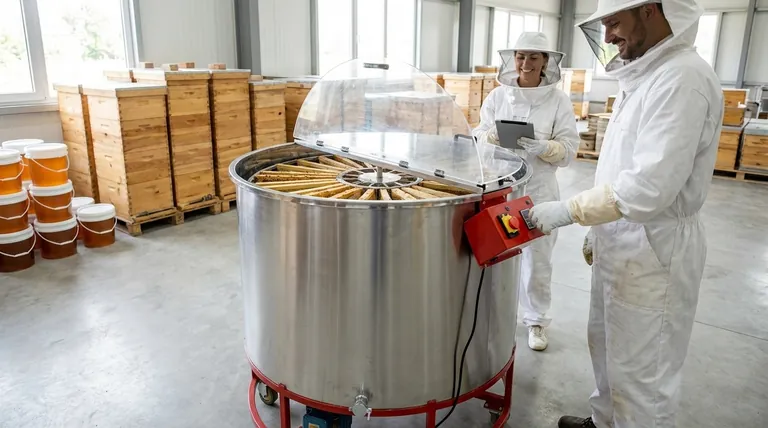For commercial beekeepers, the primary labor benefit of automated honey extractors is the profound reduction in manual effort and physical strain. This automation allows operators to process significantly more honey with less fatigue, directly boosting productivity and enabling a more efficient allocation of their time during the critical harvesting season.
Automation in honey extraction is not simply about saving time. It's about transforming labor from a limiting factor into a strategic asset, allowing beekeepers to reallocate their focus from repetitive processing to high-value activities like hive health and business growth.

The Direct Impact on Labor and Productivity
Automating the extraction process addresses the most physically demanding and time-consuming bottlenecks in a commercial honey house. This shift has immediate and measurable effects on operational capacity.
Alleviating Physical Strain
Traditional honey extraction is grueling work, involving hours of lifting, uncapping, and spinning heavy frames. Automated systems alleviate the physical strain associated with these tasks.
This makes the process more sustainable for beekeepers, especially during peak seasons when long hours are required. It reduces operator fatigue, which in turn minimizes the risk of injury and errors.
Increasing Processing Throughput
By automating the repetitive steps of uncapping, loading, and running the extractor, these systems dramatically reduce the time spent per frame. This efficiency gain allows a commercial operation to process a much larger volume of honey in the same amount of time.
This direct contribution to increased productivity is a core economic driver for adopting this technology.
Reallocating Resources for Strategic Advantage
The time saved from manual labor is not just downtime; it is a resource that can be reinvested into other critical areas of the beekeeping business.
Shifting Focus to Hive Health
With less time dedicated to the mechanics of extraction, beekeepers can allocate more resources to proactive hive management.
This includes more frequent and thorough inspections, disease prevention, and optimizing colony health, which are the true foundations of a sustainable and productive apiary.
Enabling Business Scalability
Automated systems decouple honey processing capacity from the physical limits of manual labor. This makes it easier for a commercial operation to scale its business.
Beekeepers can add more hives without facing a linear increase in labor costs and time for extraction, enabling more predictable and profitable growth.
Understanding the Trade-offs
While the labor benefits are significant, adopting automation requires a clear understanding of the associated costs and responsibilities.
The Initial Investment
The most obvious trade-off is the significant initial investment required to purchase automated extraction equipment. This cost must be weighed against the long-term gains in labor savings and productivity.
Maintenance and Technical Skill
Automated systems are more complex than their manual counterparts. They require a different type of labor focused on operation, cleaning, and maintenance. Beekeepers must be prepared to develop the technical skills needed to keep the machinery running smoothly.
Not a Cure for All Labor
It's crucial to remember that automation primarily addresses the honey house. The demanding work of managing apiaries, transporting hives, and performing inspections remains a largely manual and labor-intensive process.
Making the Right Choice for Your Operation
Deciding to invest in an automated extractor depends entirely on the strategic goals of your commercial beekeeping business.
- If your primary focus is maximizing honey output: Automation is the most direct path to increasing your processing throughput and overall productivity.
- If your primary focus is business scalability: The reduced labor cost per hive is the key to profitably expanding your operation.
- If your primary focus is improving hive management: Freeing your team from the physical demands of extraction allows for more dedicated attention to colony health.
Ultimately, adopting an automated honey extractor allows you to strategically manage your most valuable resource: your time.
Summary Table:
| Key Labor Benefit | Impact on Commercial Operation |
|---|---|
| Alleviates Physical Strain | Reduces operator fatigue and risk of injury from lifting and spinning heavy frames. |
| Increases Processing Throughput | Dramatically cuts time per frame, allowing significantly more honey to be processed in the same time. |
| Enables Strategic Reallocation | Frees up time for beekeepers to focus on high-value tasks like hive health and business scaling. |
Ready to transform your honey harvesting labor into a strategic advantage?
As HONESTBEE, we specialize in supplying robust, commercial-grade automated honey extractors and beekeeping equipment to commercial apiaries and distributors through our wholesale-focused operations. Our equipment is designed to deliver the labor savings, increased throughput, and scalability your business needs to grow profitably.
Contact our team today to discuss how our solutions can be integrated into your operation to maximize productivity and reduce physical strain.
Visual Guide

Related Products
- HONESTBEE 72 Frame Industrial Electric Honey Extractor for Beekeeping
- 8-Frame Electric Self-Reversing Honey Extractor Spinner for Commercial Honey Extraction Equipment
- Electric 8 Frame Honey Spinner Extractor Equipment for Beekeeping
- HONESTBEE 3-Frame Manual Acrylic Honey Extractor
- HONESTBEE 8 Frame Electric and Manual Three Use Honey Extractor
People Also Ask
- Why do beekeepers have to lift a lot of weight at the end of a growing season? The Reward of a Heavy Harvest
- Can a manual extractor be upgraded to an electric one? Save Labor & Boost Efficiency
- How is honey harvested from Langstroth hives? A Guide to Efficient, Comb-Preserving Extraction
- What is the energy consumption like for automatic honey extractors? Maximize Your Harvest Efficiency
- What are the two common types of honey extractors? Choose the Right Extractor for Your Apiary



















